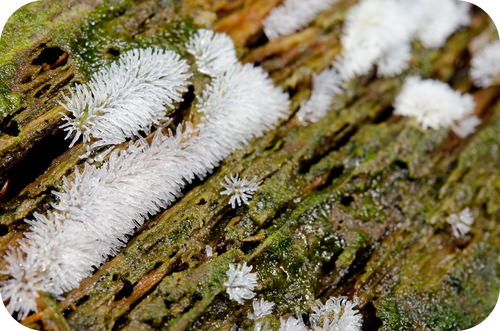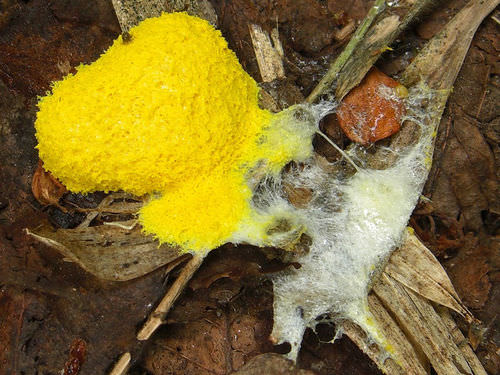8.13: Mold
- Page ID
- 1476

What grows just about anywhere there is decaying material?
Mold. This slime mold, shown growing on dead wood, is a fungus-like protist. Though this mold does not have a mouth, essentially it is still “eating” this decaying material.
Fungus-Like Protists: Molds
Fungus-like protists are molds. They are absorptive feeders on decaying organic matter. They resemble fungi, and they reproduce with spores as fungi do. However, in other ways, they are quite different from fungi and more like other protists. For example, they have cell walls made of cellulose, whereas fungi have cell walls made of chitin. Like other protists, they have complicated life cycles with both asexual and sexual reproduction. They are motile during some stages of their life cycle. Two major types of fungus-like protists are slime molds and water molds.
Slime Molds
Slime molds are fungus-like protists commonly found on rotting logs and compost. They move very slowly in search of decaying matter to eat. When food is scarce, individual cells swarm together to form a blob-like mass, like the “dog vomit” slime mold in the Figure below. The mass glides along on its own secretions, engulfing decaying organic matter as it moves over it.
 “Dog Vomit” Slime Mold. This slime mold looks like its name.
“Dog Vomit” Slime Mold. This slime mold looks like its name.There are two types of slime molds when it comes to how they swarm: acellular and cellular.
- When acellular slime molds swarm, they fuse together to form a single cell with many nuclei.
- When cellular slime molds swarm, they remain as distinct cells.
Cellular slime molds are used as model organisms in molecular biology and genetics. They may be the key to how multicellular organisms evolved. Can you explain why?
Water Molds
Water molds are commonly found in moist soil and surface water. Many are plant pathogens that destroy crops. They infect plants such as grapes, lettuce, corn, and potatoes. Some water molds are parasites of fish and other aquatic organisms.
Science Friday: The Road Best Traveled
A Tale of Ants, Slime Mold and the New Jersey Turnpike For most people, getting stuck in a traffic jam on the New Jersey Turnpike is a grueling lesson in futility. However, in this video by Science Friday, Simon Garnier examines our collective behavior and how relatively simple organisms organize themselves so dynamically.
Summary
- Fungus-like protists are molds.
- Molds are absorptive feeders, found on decaying organic matter. They resemble fungi and reproduce with spores as fungi do.
- Examples of fungus-like protists include slime molds and water molds.
Review
- How are fungus-like protists similar to fungi? What is one way they are different?
- Why might cellular slime molds, but not acellular slime molds, be the key to how multicellular organisms evolved?
| Image | Reference | Attributions |
 |
[Figure 1] | License: CC BY-NC |
 |
[Figure 2] | Credit: Jason Hollinger Source: http://www.flickr.com/photos/7147684@N03/3439872376/ License: CC BY 2.0 |

